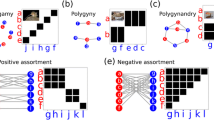Abstract
For intersexual selection to occur, it is necessary that females choose between males. It is now well appreciated that constraints exist, which preclude females sampling all the available males in a population. These constraints are likely to have caused the evolution of sampling rules (such as the “best-of-n” rule) by which females sample males. Here we investigate the impact of female subsampling of the male population, not on the evolution of sampling behaviour, but on the population-level correlation between a male trait and currencies such as reproductive success. This study is important as it illustrates when population-level correlations can be safely used to infer the presence and strength of sexual selection in the field. We find that the correlation between a male trait and a mate choice variable rises steeply as the number of males sampled by each female increases, flattening above seven to ten males sampled. This shape is found to be remarkably robust, and little affected by, for example, the mate choice variable used, by noise in assessment, by sampling behaviour depending on female quality, or by population size. The only variable found to have a large impact is male clumping according to their “quality”. If females are sampling about four males, the maximum correlation that can be found at the population level is in the range 0.4–0.6, perhaps as little as 0.1 if males are strongly clumped. A recent review of the literature suggests that four is the average number of males that females sample. Thus, the absence of a strong correlation cannot by itself be used to infer that sexual selection is weak, as it may be due to females sampling few males.
Similar content being viewed by others
Author information
Authors and Affiliations
Additional information
Received: 18 May 1998 / Accepted after revision: 18 July 1998
Rights and permissions
About this article
Cite this article
Benton, T., Evans, M. Measuring mate choice using correlation: the effect of female sampling behaviour. Behav Ecol Sociobiol 44, 91–98 (1998). https://doi.org/10.1007/s002650050520
Issue Date:
DOI: https://doi.org/10.1007/s002650050520




